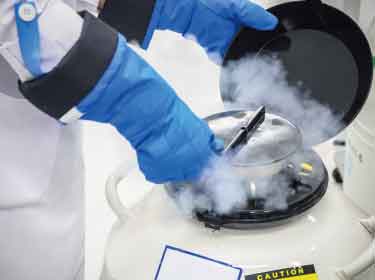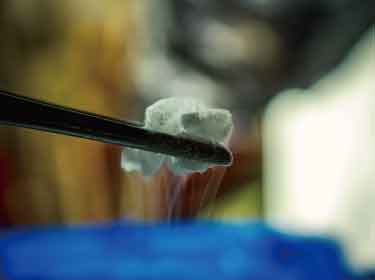Download pdf
Written by Roshini Beenukumar, PhD
Cryopreservation of cells is gaining more importance as we move towards novel cell-based therapies for cancer and other diseases. Scientists are continually looking for ways to prolong the post-thaw longevity of cells. Bailey and colleagues from the University of Warwick, UK discovered a new polymeric cryoprotectant with improved features such as higher cell recovery after freezing and lower requirement of solvent-based antifreeze.
The rising demand for cryopreservation and biobanking
The need for long-term storage of biomaterials is rising. From research labs to clinics, cryopreservation has numerous applications such as in (1) blood transfusion, (2) bone marrow transplantation, (3) artificial insemination, (4) in vitro fertilization, (5) cryosurgery, and (6) stem cell and other cell therapies. However, current cryopreservation methods do not adequately meet all the requirements. Good yield and retention of function and viability after freeze-thaw are important in both clinical (for the desired therapeutic outcome) and research applications (to ensure the correct understanding of biological phenomena).
Cryoprotectants prevent cellular damage by modulating water to ice transition
Intracellular ice formation during cryopreservation is one of the biggest challenges facing cellular cryopreservation as it could lead to irreversible cellular damage. This is where cryoprotective agents (CPAs) or cryoprotectants come into play. Cryoprotectants alter the freezing behavior of cells by modulating the rates of water transport, nucleation, and ice crystal growth. DMSO is the most common and effective cryoprotectant used by cell banks around the world. Other CPAs include glycerol (which was used to cryopreserve cattle sperm at −79°C as far back as 1949), ethylene glycol, propylene glycol, sucrose and trehalose.
Most of these cryoprotectants function by penetrating the cell membrane and replacing part of its water content. However, they become toxic, particularly, at higher concentrations due to the high osmotic pressure. Cryoprotectants such as sucrose and trehalose do not penetrate the cell membrane, instead, they stabilize and preserve the cell membranes. Such CPAs often need to be used in combination with our CPAs..

DMSO doesn’t fit all cell types – the need for alternative cryoprotectants
DMSO is the current gold standard for cryopreservation of mammalian cells in suspension. Cells are frozen in a vial with 5–10% of DMSO. However, there are multiple caveats to using DMSO as the cryoprotectant:
- Once frozen in DMSO, the cells must be propagated several times before they can be reliably used in assays.
- Many cell types are sensitive to DMSO
- DMSO is not the best option for freezing cells in monolayers as the recovery is only around 20–35%
Hence, the need for alternative cryoprotectants with better properties that overcome some or all of these challenges.
Poly-ampholytes – an emerging class of polymeric cryoprotectants
Polyampholytes such as carboxylated polylysine are charged polymers with both positively and negatively charged groups. They interact with cell membranes and show promise as a cryoprotectant in cryovial vitrification, monolayer slow-vitrification and slow-freezing in cryovials. The search for the ideal polymeric cryoprotectant with the following properties is still ongoing:
- Higher post-thaw cell yield
- Easy to remove
- Can be produced on a commercial scale
- Facilitates both suspension and monolayer preservation of cells
- Suitable for all cell types with minimal reformulation
In this study, Bailey and colleagues from the University of Warwick report a new polyampholyte cryoprotectant which meets many of the above requirements.
A promising cryoprotectant for the preservation of cellular monolayers

The new polyampholyte cryoprotectant dubbed ‘the Warwick material’ shows promise as a cryoprotectant, particularly for freezing monolayers of cells. The new material works well with a variety of cell types, including nucleated and anucleated cells in suspension and monolayers under slow-freezing conditions. The post-thaw cell yield was shown to be significantly higher for adherent cell monolayers compared to DMSO (88% using the new material versus 24% using DMSO). For those cell types which are sensitive to high DMSO concentrations, the Warwick material might be the right solution as it enables the reduction of DMSO concentration from 10 wt % to 2.5 wt % in suspension cryopreservation without compromising outcomes.
Unlike DMSO, the Warwick material does not penetrate the cell membrane and can be easily removed after thawing. Bailey and colleagues also showed reduced cell membrane damage, faster cell growth rate post-thaw and compatibility with RBCs using the new polyampholyte cryoprotectant. Moreover, the new material was produced in a single step from a clinically used commodity bulk polymer.
The mode of action of the new material was different from other polymeric cryoprotectants. Most polymeric cryoprotectants act by modulating ice formation and growth. The new Warwick material only moderately influenced ice formation and growth, but markedly increased post-thaw viability of cells in monolayers (400% compared to DMSO alone). It seems to function extracellularly instead of penetrating the cell membrane, stabilizing it during cryopreservation. The scientists also showed that RBCs when frozen with the polymer alone, showed >80% post-thaw recovery compared to glycerol. The polymer could be easily removed after thawing, which was an added advantage.
Conclusion
The need for newer and better cryoprotectants is on the rise. The new Warwick material is a step forward in our search for the ideal polymeric cryopreservative. It stabilizes cell membranes without penetration, facilitating faster post-thaw cell recovery and proliferation. Higher cell yields with the new material are beneficial for both research and clinical applications. Furthermore, cryoprotectants with better features like the Warwick material can potentially reduce costs associated with cell-based therapies and regenerative medicine.
Professor Matthew Gibson of the Department of Chemistry and Warwick Medical School and the corresponding author of the study says, "Cryopreservation is fundamental to so much modern bioscience and medicine, but we urgently need better methods to meet the needs of advanced cell-based therapies. Our new material is easy to scale up, which is essential if this is to be widely used, and we found it to be very protective for several cell lines. The simplicity of our approach will hopefully help us translate this to real applications quickly and make an impact on healthcare and basic research."
Future directions
As more cell-based therapies emerge, the research community must invest time and resources in developing methods to bank these cells in a cost-effective and safe manner. In a previous blog article, we discussed a novel super supercooling technique for long-term preservation of biomaterials . Future research should focus on developing safer cryopreservation techniques that minimally affect the integrity of biological materials and optimizing these techniques for commercial use.
"Stay informed with the latest news from PHCbi”

Reference
1. Freezing cells made safer thanks to new polymer made at University of Warwick. EurekAlert! https://www.eurekalert.org/pub_releases/2019-07/uow-fcm072919.php.
2. Bailey, T. L. et al. Synthetically Scalable Poly(ampholyte) Which Dramatically Enhances Cellular Cryopreservation. Biomacromolecules 20, 3104–3114 (2019).
3. Jang, T. H. et al. Cryopreservation and its clinical applications. Integr. Med. Res. 6, 12–18 (2017).
4. Elliott, G. D., Wang, S. & Fuller, B. J. Cryoprotectants: A review of the actions and applications of cryoprotective solutes that modulate cell recovery from ultra-low temperatures. Cryobiology 76, 74–91 (2017).
5. Matsumura, K., Bae, J. Y. & Hyon, S. H. Polyampholytes as Cryoprotective Agents for Mammalian Cell Cryopreservation. Cell Transplant. 19, 691–699 (2010).
About PHCbi
The “bi” part of our new brand PHCbi is not only a shortened form of the word “biomedical” but also represents both our strength and philosophy as an abbreviation of “biomedical innovation.”
Since the launch of our first Pharmaceutical Refrigerator model in 1966, we have taken advantage of this technology to create exceptional medical and laboratory products and services with a high degree of quality and reliability. We have worked to meet the expectations of customers in the medical and life science fields under both the Sanyo and Panasonic brands. See more detail from "About PHCbi". Find PHCbi's customer case study in the world.